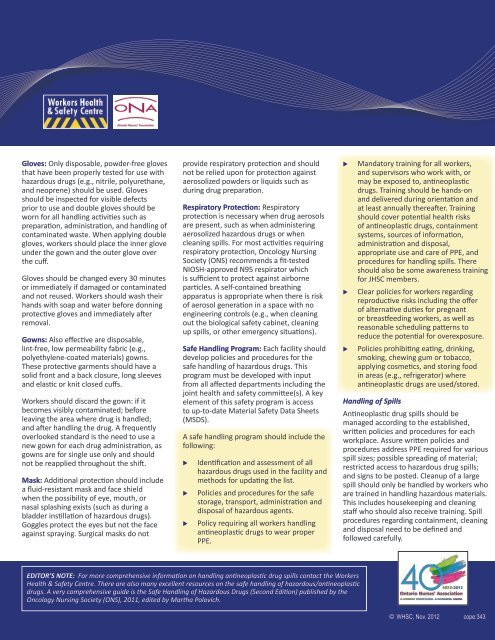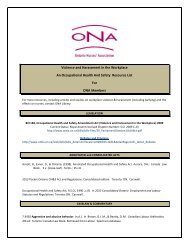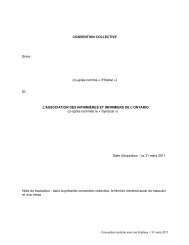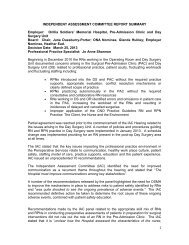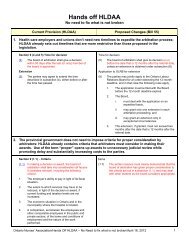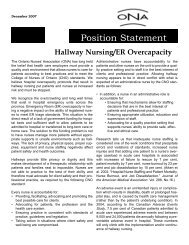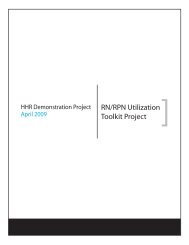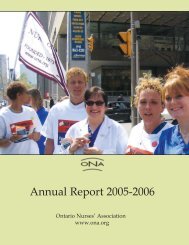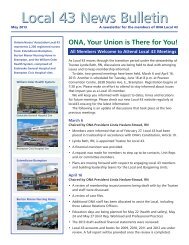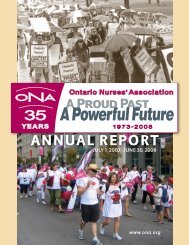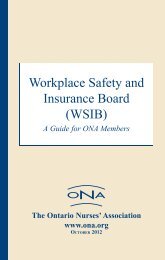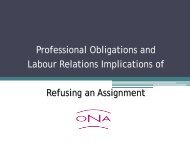Antineoplastic Drugs, Handle With Care - Ontario Nurses' Association
Antineoplastic Drugs, Handle With Care - Ontario Nurses' Association
Antineoplastic Drugs, Handle With Care - Ontario Nurses' Association
You also want an ePaper? Increase the reach of your titles
YUMPU automatically turns print PDFs into web optimized ePapers that Google loves.
Gloves: Only disposable, powder-free gloves<br />
that have been properly tested for use with<br />
hazardous drugs (e.g., nitrile, polyurethane,<br />
and neoprene) should be used. Gloves<br />
should be inspected for visible defects<br />
prior to use and double gloves should be<br />
worn for all handling activities such as<br />
preparation, administration, and handling of<br />
contaminated waste. When applying double<br />
gloves, workers should place the inner glove<br />
under the gown and the outer glove over<br />
the cuff.<br />
Gloves should be changed every 30 minutes<br />
or immediately if damaged or contaminated<br />
and not reused. Workers should wash their<br />
hands with soap and water before donning<br />
protective gloves and immediately after<br />
removal.<br />
Gowns: Also effective are disposable,<br />
lint-free, low permeability fabric (e.g.,<br />
polyethylene-coated materials) gowns.<br />
These protective garments should have a<br />
solid front and a back closure, long sleeves<br />
and elastic or knit closed cuffs.<br />
Workers should discard the gown: if it<br />
becomes visibly contaminated; before<br />
leaving the area where drug is handled;<br />
and after handling the drug. A frequently<br />
overlooked standard is the need to use a<br />
new gown for each drug administration, as<br />
gowns are for single use only and should<br />
not be reapplied throughout the shift.<br />
Mask: Additional protection should include<br />
a fluid-resistant mask and face shield<br />
when the possibility of eye, mouth, or<br />
nasal splashing exists (such as during a<br />
bladder instillation of hazardous drugs).<br />
Goggles protect the eyes but not the face<br />
against spraying. Surgical masks do not<br />
provide respiratory protection and should<br />
not be relied upon for protection against<br />
aerosolized powders or liquids such as<br />
during drug preparation.<br />
Respiratory Protection: Respiratory<br />
protection is necessary when drug aerosols<br />
are present, such as when administering<br />
aerosolized hazardous drugs or when<br />
cleaning spills. For most activities requiring<br />
respiratory protection, Oncology Nursing<br />
Society (ONS) recommends a fit-tested<br />
NIOSH-approved N95 respirator which<br />
is sufficient to protect against airborne<br />
particles. A self-contained breathing<br />
apparatus is appropriate when there is risk<br />
of aerosol generation in a space with no<br />
engineering controls (e.g., when cleaning<br />
out the biological safety cabinet, cleaning<br />
up spills, or other emergency situations).<br />
Safe Handling Program: Each facility should<br />
develop policies and procedures for the<br />
safe handling of hazardous drugs. This<br />
program must be developed with input<br />
from all affected departments including the<br />
joint health and safety committee(s). A key<br />
element of this safety program is access<br />
to up-to-date Material Safety Data Sheets<br />
(MSDS).<br />
A safe handling program should include the<br />
following:<br />
u<br />
u<br />
u<br />
Identification and assessment of all<br />
hazardous drugs used in the facility and<br />
methods for updating the list.<br />
Policies and procedures for the safe<br />
storage, transport, administration and<br />
disposal of hazardous agents.<br />
Policy requiring all workers handling<br />
antineoplastic drugs to wear proper<br />
PPE.<br />
u<br />
u<br />
u<br />
Mandatory training for all workers,<br />
and supervisors who work with, or<br />
may be exposed to, antineoplastic<br />
drugs. Training should be hands-on<br />
and delivered during orientation and<br />
at least annually thereafter. Training<br />
should cover potential health risks<br />
of antineoplastic drugs, containment<br />
systems, sources of information,<br />
administration and disposal,<br />
appropriate use and care of PPE, and<br />
procedures for handling spills. There<br />
should also be some awareness training<br />
for JHSC members.<br />
Clear policies for workers regarding<br />
reproductive risks including the offer<br />
of alternative duties for pregnant<br />
or breastfeeding workers, as well as<br />
reasonable scheduling patterns to<br />
reduce the potential for overexposure.<br />
Policies prohibiting eating, drinking,<br />
smoking, chewing gum or tobacco,<br />
applying cosmetics, and storing food<br />
in areas (e.g., refrigerator) where<br />
antineoplastic drugs are used/stored.<br />
Handling of Spills<br />
<strong>Antineoplastic</strong> drug spills should be<br />
managed according to the established,<br />
written policies and procedures for each<br />
workplace. Assure written policies and<br />
procedures address PPE required for various<br />
spill sizes; possible spreading of material;<br />
restricted access to hazardous drug spills;<br />
and signs to be posted. Cleanup of a large<br />
spill should only be handled by workers who<br />
are trained in handling hazardous materials.<br />
This includes housekeeping and cleaning<br />
staff who should also receive training. Spill<br />
procedures regarding containment, cleaning<br />
and disposal need to be defined and<br />
followed carefully.<br />
EDITOR’S NOTE: For more comprehensive information on handling antineoplastic drug spills contact the Workers<br />
Health & Safety Centre. There are also many excellent resources on the safe handling of hazardous/antineoplastic<br />
drugs. A very comprehensive guide is the Safe Handling of Hazardous <strong>Drugs</strong> (Second Edition) published by the<br />
Oncology Nursing Society (ONS), 2011, edited by Martha Polovich.<br />
© WHSC, Nov. 2012 cope:343


